
Topic 9 - Wave Phenomena
Question 1
HLPaper 2Two loudspeakers, A and B, are driven in phase and with the same amplitude at a frequency of . Point P is located from A and from B. The speed of sound is .

In another experiment, loudspeaker A is stationary and emits sound with a frequency of . The microphone is moving directly away from the loudspeaker with a constant speed . The frequency of sound recorded by the microphone is .
Deduce that a minimum intensity of sound is heard at P.
A microphone moves along the line from P to Q. PQ is normal to the line midway between the loudspeakers.
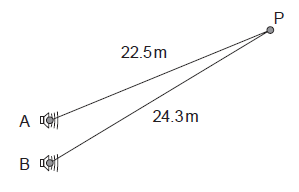
The intensity of sound is detected by the microphone. Predict the variation of detected intensity as the microphone moves from P to Q.
When both loudspeakers are operating, the intensity of sound recorded at Q is . Loudspeaker B is now disconnected. Loudspeaker A continues to emit sound with unchanged amplitude and frequency. The intensity of sound recorded at Q changes to . Estimate
Explain why the frequency recorded by the microphone is lower than the frequency emitted by the loudspeaker.
Calculate .
Question 2
HLPaper 2Monochromatic light from two identical lamps arrives on a screen.
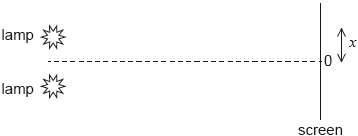
The intensity of light on the screen from each lamp separately is .
On the axes, sketch a graph to show the variation with distance on the screen of the intensity of light on the screen.

The slit separation is increased. Outline one change observed on the screen.
Monochromatic light from a single source is incident on two thin, parallel slits.

The following data are available.
\begin{array}{*{20}{l}} \text{{Slit separation}} & = 0.12 \text{{ mm}} \\ \text{{Wavelength}} & = 680 \text{{ nm}} \\ \text{{Distance to screen}} & = 3.5 \text{{ m}} \end{array}The intensity I of light at the screen from each slit separately is I0. Sketch, on the axes, a graph to show the variation with distance x on the screen of the intensity of light on the screen for this arrangement.

Question 3
HLPaper 2A buoy, floating in a vertical tube, generates energy from the movement of water waves on the surface of the sea. When the buoy moves up, a cable turns a generator on the sea bed producing power. When the buoy moves down, the cable is wound in by a mechanism in the generator and no power is produced.
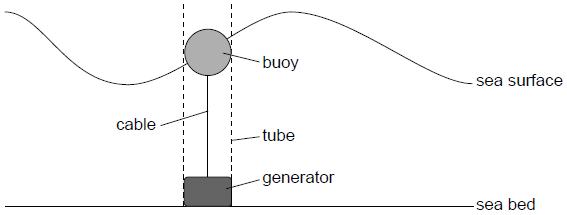
The motion of the buoy can be assumed to be simple harmonic.
Water can be used in other ways to generate energy.
Outline the conditions necessary for simple harmonic motion (SHM) to occur.
A wave of amplitude 4.3 m and wavelength 35 m, moves with a speed of 3.4 m/s. Calculate the maximum vertical speed of the buoy.
Sketch a graph to show the variation with time of the generator output power. Label the time axis with a suitable scale.

Outline, with reference to energy changes, the operation of a pumped storage hydroelectric system.
The water in a particular pumped storage hydroelectric system falls a vertical distance of 270 m to the turbines. Calculate the speed at which water arrives at the turbines. Assume that there is no energy loss in the system.
The hydroelectric system has four 250 MW generators. Determine the maximum time for which the hydroelectric system can maintain full output when a mass of kg of water passes through the turbines.
Not all the stored energy can be retrieved because of energy losses in the system. Explain two such losses.
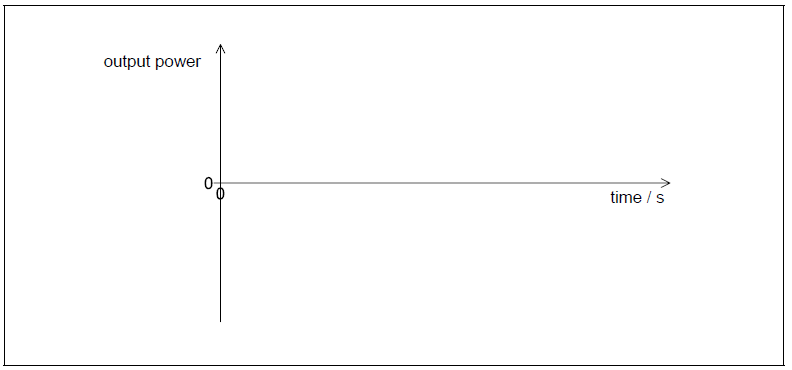
Question 4
HLPaper 2A small metal pendulum bob is suspended at rest from a fixed point with a length of thread of negligible mass. Air resistance is negligible.
The pendulum begins to oscillate. Assume that the motion of the system is simple harmonic, and in one vertical plane.
The graph shows the variation of kinetic energy of the pendulum bob with time.
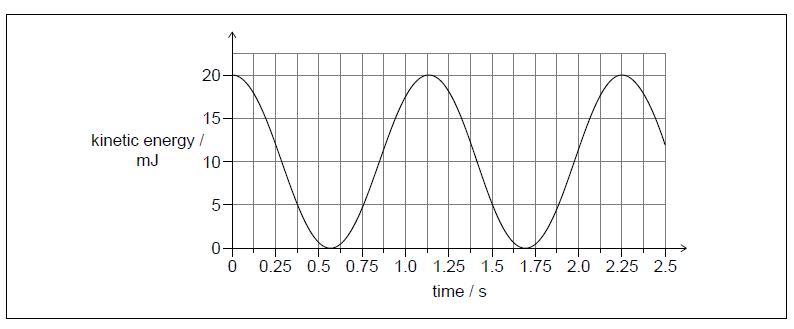
When the 75 g bob is moving horizontally at 0.80 m/s, it collides with a small stationary object also of mass 75 g. The object and the bob stick together.
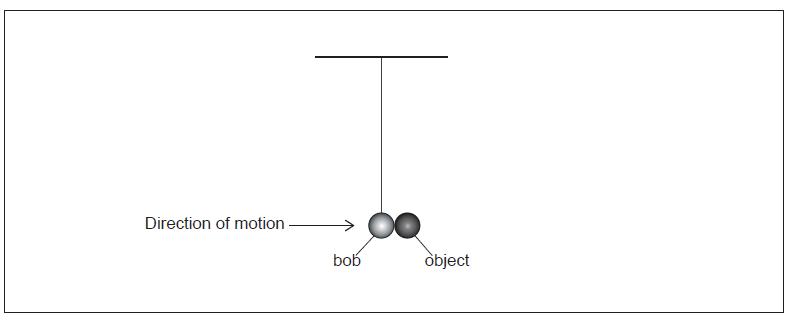
Calculate, in m, the length of the thread. State your answer to an appropriate number of significant figures.
Label on the graph with the letter X a point where the speed of the pendulum is half that of its initial speed.
The mass of the pendulum bob is 75 g. Show that the maximum speed of the bob is about 0.7 m/s–1.
Calculate the speed of the combined masses immediately after the collision.
Show that the collision is inelastic.
Sketch, on the axes, a graph to show the variation of gravitational potential energy with time for the bob and the object after the collision. The data from the graph used in (a) is shown as a dashed line for reference.
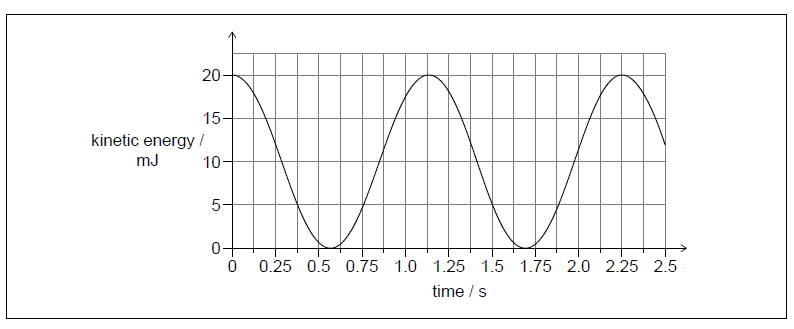
The speed after the collision of the bob and the object was measured using a sensor. This sensor emits a sound of frequency and this sound is reflected from the moving bob. The sound is then detected by the sensor as frequency .
Explain why and are different.
Question 5
HLPaper 1A diffraction grating is used to observe light of wavelength nm. The light illuminates slits of the grating. What is the minimum wavelength difference that can be resolved when the second order of diffraction is viewed?
Question 6
HLPaper 1A transparent liquid forms a parallel-sided thin film in air. The diagram shows a ray I incident on the upper air–film boundary at normal incidence (the rays are shown at an angle to the normal for clarity).
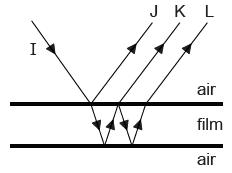
Reflections from the top and bottom surfaces of the film result in three rays J, K, and L. Which of the rays has undergone a phase change of rad?
Question 7
HLPaper 1Light of wavelength is diffracted after passing through a very narrow single slit of width . The intensity of the central maximum of the diffracted light is . The slit width is doubled.
What is the intensity of central maximum and the angular position of the first minimum?
| Intensity | Angular position of first minimum | |
|---|---|---|
| A. | ||
| B. | ||
| C. | ||
| D. |
Question 8
HLPaper 2Two loudspeakers A and B are initially equidistant from a microphone M. The frequency and intensity emitted by A and B are the same. A and B emit sound in phase. A is fixed in position.

B is moved slowly away from M along the line MP. The graph shows the variation with distance travelled by B of the received intensity at M.
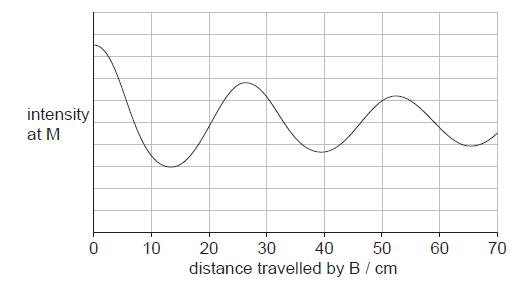
Explain why the received intensity varies between maximum and minimum values.
State and explain the wavelength of the sound measured at M.
B is placed at the first minimum. The frequency is then changed until the received intensity is again at a maximum. Show that the lowest frequency at which the intensity maximum can occur is about 3 kHz. Speed of sound = 340 m s-1
Loudspeaker A is switched off. Loudspeaker B moves away from M at a speed of 1.5 m s-1while emitting a frequency of 3.0 kHz.
Determine the difference between the frequency detected at M and that emitted by B.
Question 9
HLPaper 1An observer with an eye of pupil diameter views the headlights of a car that emit light of wavelength . The distance between the headlights is . What is the greatest distance between the observer and the car at which the images of the headlights will be resolved by the observer’s eye?
Question 10
HLPaper 1For fringes to be observed in a double-slit interference experiment, the slits must emit waves that are coherent.
What conditions are required for the frequency of the waves and for the phase difference between the waves so that the waves are coherent?
| Frequency of waves | Phase difference between waves | |
|---|---|---|
| A. | same | variable |
| B. | same | constant |
| C. | constant difference | variable |
| D. | constant difference | constant |
